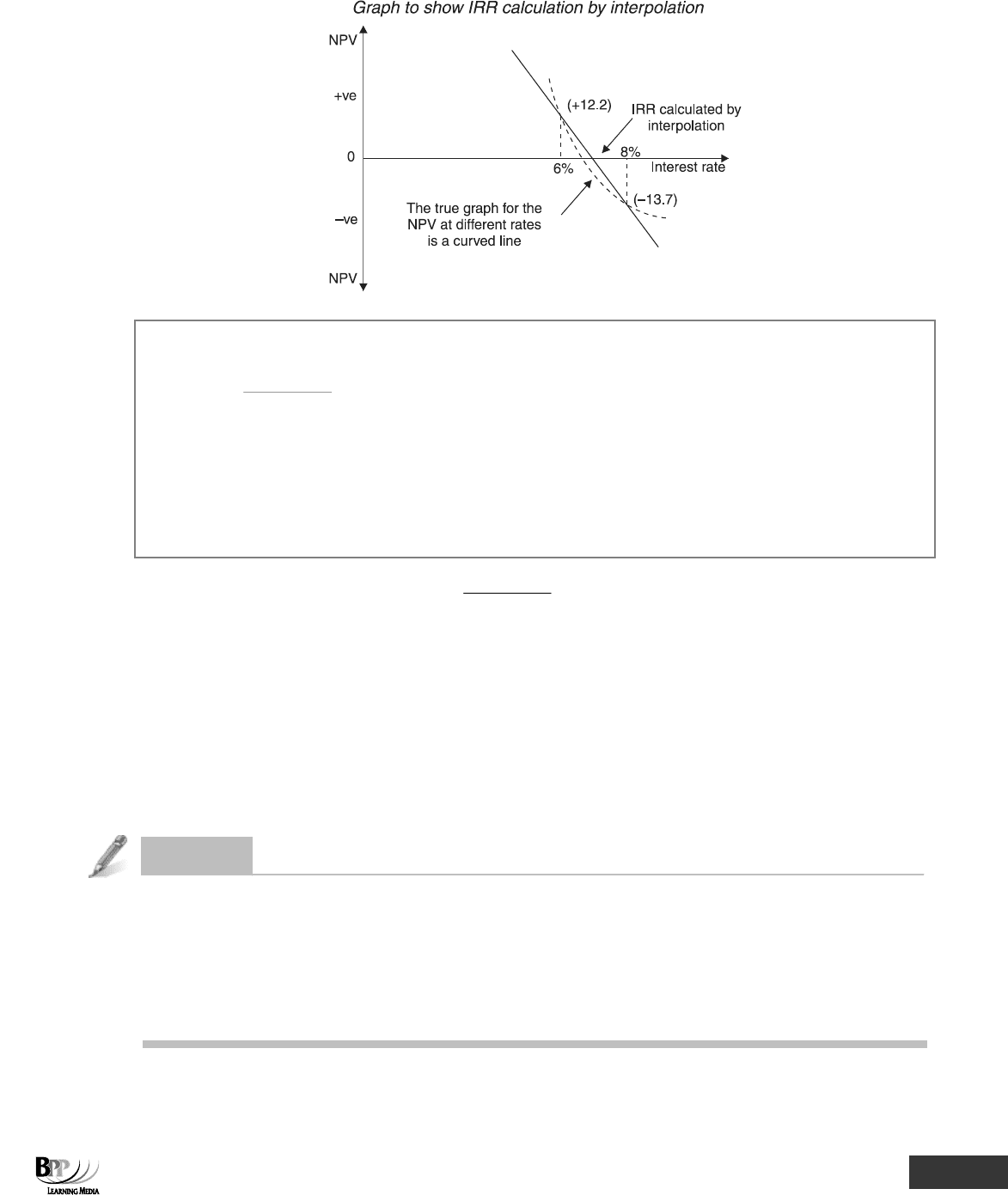CIMA - C3 Fundamentals Of Business Mathematics
Подождите немного. Документ загружается.


240 9: Discounting and basic investment appraisal ⏐ Part D Financial mathematics
2.4 Example: Expected net present value
An organisation with a cost of capital of 5% is contemplating investing $340,000 in a project which has a 25%
chance of being a big success and producing cash inflows of $210,000 after one and two years. There is, however,
a 75% chance of the project not being quite so successful, in which case the cash inflows will be $162,000 after
one year and $174,000 after two years.
Required
Calculate an NPV and hence advise the organisation.
Solution
Discount
Success
Failure
Year
factor
Cash flow
PV
Cash flow
PV
5%
$'000
$'000
$'000
$'000
0
1.000
(340)
(340.00)
(340)
(340.000)
1
0.952
210
199.92
162
154.224
2
0.907
210
190.47
174
157.818
50.39
(27.958)
NPV = (25% × 50.39) + (75% × –27.958) = –8.371
The NPV is –$8,371 and hence the organisation should not invest in the project.
2.5 Limitations of using the NPV method
There are a number of problems associated with using the NPV method in practice.
(a) The future discount factors (or interest rates) which are used in calculating NPVs can only be
estimated and are not known with certainty. Discount rates that are estimated for time periods far
into the future are therefore less likely to be accurate, thereby leading to less accurate NPV values.
(b) Similarly, NPV calculations make use of estimated
future cash flows. As with future discount
factors, cash flows which are estimated for cash flows several years into the future cannot really be
predicted with any real certainty.
(c) When using the NPV method it is common to assume that all cash flows occur
at the end of the
year
. However, this assumption is also likely to give rise to less accurate NPV values.
There are a number of computer programs available these days which enable a range of NPVs to be calculated for a
number of different circumstances (best-case and worst-case situations and so on). Such programs allow some of the
limitations mentioned above to be alleviated. We will look at how Excel can be used to calculate NPVs at the end of this
chapter.

Part D Financial mathematics ⏐ 9: Discounting and basic investment appraisal 241
3 The Internal Rate of Return (IRR) method
3.1 IRR method
The IRR method determines the rate of interest (the IRR) at which the NPV is 0. Interpolation, using the following
formula, is often necessary. The project is viable if the IRR exceeds the minimum acceptable return.
IRR = a% + %)ab(
NPVNPV
NPV
b
a
a
⎥
⎥
⎦
⎤
⎢
⎢
⎣
⎡
−
⎟
⎟
⎠
⎞
⎜
⎜
⎝
⎛
−
The internal rate of return (IRR) method of evaluating investments is an alternative to the NPV method. The NPV
method of discounted cash flow determines whether an investment earns a
positive or a negative NPV when
discounted at a given rate of interest
. If the NPV is zero (that is, the present values of costs and benefits are
equal) the return from the project would be exactly the rate used for discounting.
The IRR method will indicate that a project is viable
if the IRR exceeds the minimum acceptable rate of return.
Thus if the company expects a minimum return of, say, 15%, a project would be viable if its IRR is more than 15%.
3.2 Example: The IRR method over one year
If $500 is invested today and generates $600 in one year's time, the internal rate of return (r) can be calculated as
follows.
PV of cost = PV of benefits
500 =
)r1(
600
+
500 (1 + r) = 600
1 + r =
500
600
= 1.2
r = 0.2 = 20%
3.3 Interpolation method
The arithmetic for calculating the IRR is more complicated for investments and cash flows extending over a period
of time longer than one year. A technique known as the
interpolation method can be used to calculate an
approximate IRR.
3.4 Example: Interpolation
A project costing $800 in year 0 is expected to earn $400 in year 1, $300 in year 2 and $200 in year 3.
Required
Calculate the internal rate of return.
FA
S
T F
O
RWAR
D

242 9: Discounting and basic investment appraisal ⏐ Part D Financial mathematics
Solution
The IRR is calculated by first of all finding the NPV at each of two interest rates. Ideally, one interest rate should
give a small positive NPV and the other a small negative NPV. The IRR would then be somewhere between these
two interest rates: above the rate where the NPV is positive, but below the rate where the NPV is negative.
A very rough guideline for estimating at what interest rate the NPV might be close to zero, is to take
⎟
⎟
⎠
⎞
⎜
⎜
⎝
⎛
×
rojectt of the pcos
profit
3
2
In our example, the total profit over three years is $(400 + 300 + 200 – 800) = $100. An approximate IRR is
therefore calculated as:
800
100
3
2
× = 0.08 approx.
A starting point is to try 8%.
(a) Try 8%
Year
Cash flow
Discount factor
Present value
$
8%
$
0
(800)
1.000
(800.0)
1
400
0.926
370.4
2
300
0.857
257.1
3
200
0.794
158.8
NPV
(13.7)
The NPV is negative, therefore the project fails to earn 8% and the IRR must be less than 8%.
(b) Try 6%
Year
Cash flow
Discount factor
Present value
$
6%
$
0
(800)
1.000
(800.0)
1
400
0.943
377.2
2
300
0.890
267.0
3
200
0.840
168.0
NPV
12.2
The NPV is positive, therefore the project earns more than 6% and less than 8%.
The
IRR is now calculated by interpolation. The result will not be exact, but it will be a close
approximation. Interpolation assumes that the NPV falls in a straight line from +12.2 at 6% to –13.7 at 8%.

Part D Financial mathematics ⏐ 9: Discounting and basic investment appraisal 243
The IRR, where the NPV is zero, can be calculated as follows.
IRR =
a
ab
NPV
a(ba)%
NPV NPV
⎡⎤
⎛⎞
+−
⎢⎥
⎜⎟
−
⎝⎠
⎣⎦
Where a is one interest rate
b is the other interest rate
NPV
a
is the NPV at rate a
NPV
b
is the NPV at rate b
(c) Thus, in our example, IRR = 6% +
()
%)68(
7.132.12
2.12
⎥
⎦
⎤
⎢
⎣
⎡
−×
+
= 6% + 0.942%
= 6.942% approx
(d) The answer is only an
approximation because the NPV falls in a slightly curved line and not a straight line
between +12.2 and –13.7. Provided that NPVs close to zero are used, the linear assumption used in the
interpolation method is nevertheless fairly accurate.
(e) Note that the formula will still work if A and B are both positive, or both negative, and even if a and b are a
long way from the true IRR, but the results will be less accurate.
Question
Internal rate of return
The net present value of an investment at 15% is $50,000 and at 20% is – $10,000. The internal rate of return of
this investment (to the nearest whole number) is:
A 16%
B 17%
C 18%
D 19%
Formula to
learn

244 9: Discounting and basic investment appraisal ⏐ Part D Financial mathematics
Answe
r
IRR = a% +
%)ab(
NPVNPV
NPV
b
a
a
⎥
⎥
⎦
⎤
⎢
⎢
⎣
⎡
−
⎟
⎟
⎠
⎞
⎜
⎜
⎝
⎛
−
Where a = one interest rate = 15%
b = other interest rate = 20%
NPV
a
= NPV at rate a = $50,000
NPV
b
= NPV at rate b = –$10,000
IRR = 15% +
⎥
⎦
⎤
⎢
⎣
⎡
−×
−−
)1520(
)000,10£(000,50£
000,50£
%
= 15% + 4.17%
= 19.17%
= 19%
The correct answer is therefore D.
4 Annuities and perpetuities
4.1 Annuities
An annuity is a constant sum of money received or paid each year for a given number of years.
Many individuals nowadays may invest in annuities which can be purchased either through a single payment or a
number of payments. For example, individuals planning for their retirement might make regular payments into a
pension fund over a number of years. Over the years, the pension fund should (hopefully) grow and the final value
of the fund can be used to buy an annuity.
An
annuity might run until the recipient's death, or it might run for a guaranteed term of n years.
4.2 The annuity formula
The syllabus for Business Mathematics states that you need to be able to calculate the present value of an annuity
using both a formula and CIMA Tables. Let's have a look at the formula you need to be able to use when
calculating the PV of an annuity.
The
present value of an annuity of $1 per annum receivable or payable for n years commencing in one year,
discounted at r% per annum, can be calculated using the following formula.
PV =
n
11
1
r
(1 r)
⎛⎞
−
⎜⎟
⎜⎟
+
⎝⎠
Note that it is the PV of an annuity of $1 and so you need to multiply it by the actual value of the annuity.
Assessment
formula
FA
S
T F
O
RWAR
D

Part D Financial mathematics ⏐ 9: Discounting and basic investment appraisal 245
4.3 Example: The annuity formula
What is the present value of $4,000 per annum for years 1 to 4, at a discount rate of 10% per annum?
Solution
Using the annuity formula with r = 0.1 and n = 4.
PV = $4,000
×
⎟
⎟
⎠
⎞
⎜
⎜
⎝
⎛
⎟
⎟
⎠
⎞
⎜
⎜
⎝
⎛
+
−
4
)
1.01
(
1
1
1.0
1
= $4,000 × 3.170 = $12,680
4.4 Calculating a required annuity
If PV of $1 =
⎟
⎟
⎠
⎞
⎜
⎜
⎝
⎛
+
−
n
r)1(
1
1
r
1
, then PV of $a = a
⎟
⎟
⎠
⎞
⎜
⎜
⎝
⎛
⎟
⎟
⎠
⎞
⎜
⎜
⎝
⎛
+
−
n
)
r1
(
1
1
r
1
∴ a =
⎟
⎟
⎠
⎞
⎜
⎜
⎝
⎛
⎟
⎟
⎠
⎞
⎜
⎜
⎝
⎛
+
−
n
)r1(
1
1
r
1
$a of PV
This enables us to calculate the annuity required to yield a given rate of return (r) on a given investment (P).
4.5 Example: required annuity
The present value of a ten-year receivable annuity which begins in one year's time at 7% per annum compound is
$3,000. What is the annual amount of the annuity?
Solution
PV of $a = $3,000
r = 0.07
t = 10
a =
⎟
⎟
⎟
⎠
⎞
⎜
⎜
⎜
⎝
⎛
⎟
⎟
⎟
⎠
⎞
⎜
⎜
⎜
⎝
⎛
−
10
)07.1(
1
1
07.0
1
000,3$
=
024.7
000,3$
= 427.11
Question
Annuity formula (1)
(a) It is important to practise using the annuity factor formula. Calculate annuity factors in the following cases.
(i) n = 4, r = 10%
(ii) n = 3, r = 9.5%
(iii) For twenty years at a rate of 25%

246 9: Discounting and basic investment appraisal ⏐ Part D Financial mathematics
(b) What is the present value of $4,000 per annum for four years, years 2 to 5, at a discount rate of 10% per
annum? Use the annuity formula.
Answe
r
(a) (i)
⎟
⎟
⎠
⎞
⎜
⎜
⎝
⎛
+
−
4
)1.01(
1
1
1.0
1
= 3.170
(ii)
⎟
⎟
⎠
⎞
⎜
⎜
⎝
⎛
+
−
3
)095.01(
1
1
095.0
1
= 2.509
(iii)
⎟
⎟
⎠
⎞
⎜
⎜
⎝
⎛
+
−
20
)25.01(
1
1
25.0
1
= 3.954
(b) The formula will give the value of $4,000 at 10% per annum, not as a year 0 present value, but as a value at
the year preceding the first annuity cash flow, that is, at year (2 – 1) = year 1. We must therefore discount
our solution in paragraph 4.3 further, from a year 1 to a year 0 value.
PV = $12,680 ×
10.1
1
= $11,527.27
Question
Annuity formula (2)
In the formula
PV =
−
+
⎛⎞
⎜⎟
⎜⎟
⎝⎠
n
1
1
1
r
(1 r)
r = 0.04
n = 10
What is the PV?
A 6.41
B 7.32
C 8.11
D 9.22
Answe
r
PV =
⎟
⎟
⎠
⎞
⎜
⎜
⎝
⎛
+
−
10
)04.01(
1
1
04.0
1
= 8.11
The correct answer is therefore C.

Part D Financial mathematics ⏐ 9: Discounting and basic investment appraisal 247
4.6 Annuity tables
To calculate the present value of a constant annual cash flow, or annuity, we can multiply the annual cash flows by
the sum of the discount factors for the relevant years. These total factors are known as
cumulative present value
factors
or annuity factors. As with 'present value factors of $1 in year n', there are tables for annuity factors, which
are shown at the end of this text. (For example, the cumulative present value factor of $1 per annum for five years
at 11% per annum is in the column for 11% and the year 5 row, and is 3.696).
4.7 The use of annuity tables to calculate a required annuity
The present value of an annuity can also be calculated using the annuity factors found in annuity tables.
Annuity (a) =
factor Annuity
annuityanofvaluePresent
4.8 Example: Annuity tables
A bank grants a loan of $3,000 at 7% per annum. The borrower is to repay the loan in ten annual instalments. How
much must she pay each year?
Solution
Since the bank pays out the loan money now, the present value (PV) of the loan is $3,000. The annual repayment
on the loan can be thought of as an annuity. We can therefore use the annuity formula
Annuity =
factor annuity
PV
in order to calculate the loan repayments. The annuity factor is found by looking in the cumulative present value
tables under n = 10 and r = 7%. The corresponding factor = 7.024.
Therefore, annuity =
024.7
000,3$
= $427.11
The loan repayments are therefore $427.11 per annum.
4.9 Perpetuities
A perpetuity is an annuity which lasts for ever, instead of stopping after n years. The present value of a perpetuity
is PV = a/r where r is the cost of capital as a proportion.
The present value of $1 per annum, payable or receivable in perpetuity, commencing in one year, discounted at r%
per annum
PV =
1
r
Assessment
formula
FA
S
T F
O
RWAR
D
FA
S
T F
O
RWAR
D

248 9: Discounting and basic investment appraisal ⏐ Part D Financial mathematics
4.10 Example: A perpetuity
How much should be invested now (to the nearest $) to receive $35,000 per annum in perpetuity if the annual rate
of interest is 9%?
Solution
PV =
r
a
Where a = $35,000
r = 9%
∴
PV =
09.0
000,35$
= $388,889
4.11 Example: A perpetuity again
Mostly Co is considering a project which would cost $50,000 now and yield $9,000 per annum every year in
perpetuity, starting a year from now. The cost of capital is 15%.
Required
Assess whether the project is viable.
Solution
Year
Cash flow
Discount factor
Present value
$
15%
$
0
(50,000)
1.0
(50,000)
1– ∞
9,000
1/0.15
60,000
NPV
10,000
The project is viable because it has a positive net present value when discounted at 15%.
4.12 The timing of cash flows
Note that both annuity tables and the formulae assume that the first payment or receipt is a year from now. Always
check assessment questions for when the first payment falls.
For example, if there are five equal payments starting now, and the interest rate is 8%, we should use a factor of 1
(for today's payment) + 3.312 (for the other four payments) = 4.312.
Question
Present value of a lease
Hilarious Jokes Co has arranged a fifteen year lease, at an annual rent of $9,000. The first rental payment is to be
paid immediately, and the others are to be paid at the end of each year.
What is the present value of the lease at 9%?
A $79,074 C $81,549
B $72,549 D $70,074

Part D Financial mathematics ⏐ 9: Discounting and basic investment appraisal 249
Answe
r
The correct way to answer this question is to use the cumulative present value tables for r = 9% and n = 14
because the first payment is to be paid immediately (and not in one year's time). A common trap in a question like
this would be to look up r = 9% and n = 15 in the tables. If you did this, get out of the habit now, before you take
your assessment!
From the cumulative present value tables, when r = 9% and n = 14, the annuity factor is 7.786.
The first payment is made now, and so has a PV of $9,000 ($9,000
× 1.00). Payments 2-15 have a PV of $9,000 ×
7.786 = $70,074.
∴ The total PV = $9,000 (1st payment) + $70,074 (Payments 2-15)
= $79,074.
The correct answer is A.
(Alternatively, the annuity factor can be increased by 1 to take account of the fact that the first payment is
now.
∴ annuity factor = 7.786 + 1 = 8.786
∴ PV = annuity × annuity factor
= $9,000
× 8.786 = $79,074)
Question
Perpetuities
How much should be invested now (to the nearest $) to receive $20,000 per annum in perpetuity if the annual rate
of interest is 20%?
A $4,000
B $24,000
C $93,500
D $100,000
Answe
r
PV =
r
a
Where a = annuity = $20,000
r = cost of capital as a proportion = 0.2
PV =
2.0
000,20$
= $100,000
The correct answer is therefore D.
